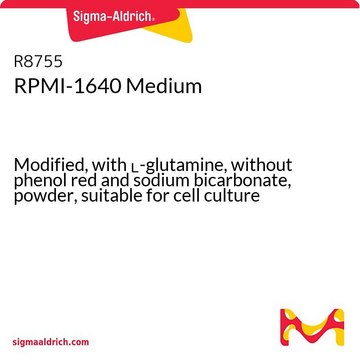51536C
RPMI-1640 Medium
with 2.05 mM L-glutamine, with 25mM HEPES, liquid, sterile-filtered, suitable for cell culture
Pharma Manufacturing
Sign Into View Organizational & Contract Pricing
All Photos(1)
About This Item
Recommended Products
description
for research or for further manufacturing use
Quality Level
sterility
sterile-filtered
form
liquid
technique(s)
cell culture | hybridoma: suitable
cell culture | mammalian: suitable
components
HEPES: 5958 mg/L
L-glutamine: 300 mg/L
NaHCO3: 2000 mg/L
phenol red: 5.310 mg/L
shipped in
ambient
storage temp.
2-8°C
Looking for similar products? Visit Product Comparison Guide
General description
RPMI 1640 Medium was developed at Roswell Park Memorial Institute in 1966 by Moore and his co-workers. A modification of McCoy′s 5A Medium, it was formulated to support lymphoblastoid cells in suspension culture, but it has since been shown to support a wide variety of cells that are anchorage dependent.
RPMI 1640 Medium was developed at Roswell Park Memorial Institute in 1966 by Moore and his co-workers. A modification of McCoy′s 5A Medium, it was formulated to support lymphoblastoid cells in suspension culture, but it has since been shown to support a wide variety of cells that are anchorage-dependent. Originally intended to be used with a serum supplement, RPMI 1640 has been shown to support several cell lines in the absence of serum. It has also been widely used in fusion protocols and in the growth of hybrid cells. This medium is suitable for culturing human normal and neoplastic leukocytes.
Application
RPMI-1640 Medium has been used to incubate dissected lung tissue.
supplement
Product No.
Description
Pricing
Storage Class Code
12 - Non Combustible Liquids
WGK
WGK 1
Flash Point(F)
Not applicable
Flash Point(C)
Not applicable
Personal Protective Equipment
dust mask type N95 (US), Eyeshields, Gloves
Choose from one of the most recent versions:
Already Own This Product?
Find documentation for the products that you have recently purchased in the Document Library.
Customers Also Viewed
Defining the inflammatory signature of human lung explant tissue in the presence and absence of glucocorticoid.
Tracy L R, et al.
F1000Research, 6 (2017)
Ananthakrishnan Soundaram Jeevarathinam et al.
Angewandte Chemie (International ed. in English) (2019-12-17)
We report a new approach to monitor drug release from nanocarriers via a paclitaxel-methylene blue conjugate (PTX-MB) with redox activity. This construct is in a photoacoustically silent reduced state inside poly(lactic-co-glycolic acid) (PLGA) nanoparticles (PTX-MB@PLGA NPs). During release, PTX-MB is
Sven D Willger et al.
PLoS pathogens, 4(11), e1000200-e1000200 (2008-11-08)
At the site of microbial infections, the significant influx of immune effector cells and the necrosis of tissue by the invading pathogen generate hypoxic microenvironments in which both the pathogen and host cells must survive. Currently, whether hypoxia adaptation is
Ryoichi Arita et al.
Diabetes, 58(1), 215-226 (2008-10-09)
Leukocyte adhesion in retinal microvasuculature substantially contributes to diabetic retinopathy. Involvement of the Rho/Rho kinase (ROCK) pathway in diabetic microvasculopathy and therapeutic potential of fasudil, a selective ROCK inhibitor, are investigated. Localization of RhoA/ROCK and Rho activity were examined in
M M Thomas et al.
The international journal of tuberculosis and lung disease : the official journal of the International Union against Tuberculosis and Lung Disease, 12(6), 651-657 (2008-05-22)
Hospital in-patients with suspected tuberculous meningitis (TBM), predominantly in India. To determine whether interferon-gamma (IFN-gamma) secreting Mycobacterium tuberculosis antigen-specific T-cells are present in the cerebrospinal fluid (CSF) of patients with TBM and to evaluate the feasibility of CSF enzyme-linked immunospot
Our team of scientists has experience in all areas of research including Life Science, Material Science, Chemical Synthesis, Chromatography, Analytical and many others.
Contact Technical Service




